Malaria Parasites
Malaria parasites are micro-organisms that belong to the genus Plasmodium. There are more than 100 species of Plasmodium, which can infect many animal species such as reptiles, birds, and various mammals. Four species of Plasmodium have long been recognized to infect humans in nature. In addition there is one species that naturally infects macaques which has recently been recognized to be a cause of zoonotic malaria in humans. (There are some additional species which can, exceptionally or under experimental conditions, infect humans.)
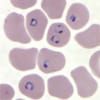
Ring-form trophozoites of P. falciparum in a thin blood smear.
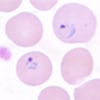
Ring-form trophozoites of P. vivax in a thin blood smear.
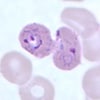
Trophozoites of P. ovale in a thin blood smear.
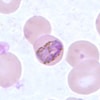
Band-form trophozoites of P. malariae in a thin blood smear.
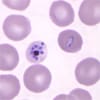
Schizont and ring-form trophozoite of P. knowlesi in a thin blood smear.
(All photos courtesy of DPDx)
The species infecting humans are:
- P. falciparum, which is found worldwide in tropical and subtropical areas, and especially in Africa where this species predominates. P. falciparum can cause severe malaria because it multiples rapidly in the blood, and can thus cause severe blood loss (anemia). In addition, the infected parasites can clog small blood vessels. When this occurs in the brain, cerebral malaria results, a complication that can be fatal.
- P. vivax, which is found mostly in Asia, Latin America, and in some parts of Africa. Because of the population densities especially in Asia it is probably the most prevalent human malaria parasite. P. vivax (as well as P. ovale) has dormant liver stages (“hypnozoites”) that can activate and invade the blood (“relapse”) several months or years after the infecting mosquito bite.
- P. ovale is found mostly in Africa (especially West Africa) and the islands of the western Pacific. It is biologically and morphologically very similar to P. vivax. However, differently from P. vivax, it can infect individuals who are negative for the Duffy blood group, which is the case for many residents of sub-Saharan Africa. This explains the greater prevalence of P. ovale (rather than P. vivax ) in most of Africa.
- P. malariae, found worldwide, is the only human malaria parasite species that has a quartan cycle (three-day cycle). (The three other species have a tertian, two-day cycle.) If untreated, P. malariae causes a long-lasting, chronic infection that in some cases can last a lifetime. In some chronically infected patients P. malariae can cause serious complications such as the nephrotic syndrome.
- P. knowlesi is found throughout Southeast Asia as a natural pathogen of long-tailed and pig-tailed macaques. It has recently been shown to be a significant cause of zoonotic malaria in that region, particularly in Malaysia. P. knowlesi has a 24-hour replication cycle and so can rapidly progress from an uncomplicated to a severe infection; fatal cases have been reported.
See Also:
–>
- Page last reviewed: March 29, 2018
- Page last updated: March 29, 2018
- Content source:


 ShareCompartir
ShareCompartir